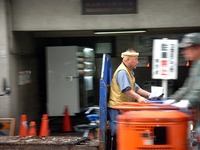 |
| Angelika/Mike Schilli |
|
Angelika In Kyoto, we rented a room in a ryokan - a traditional Japanese inn. The term "inn" might sound a bit rustic, but a ryokan is more of an upscale version. It allows you to immerse yourself in ancient Japan.
Following the custom of removing shoes is very important in a ryokan. The room itself consists of tatami mats and a low table, where meals are eaten while sitting on the mat. In a ryokan, meals are typically served in the room by a lady dressed in a kimono. Usually, both Japanese breakfast and dinner are offered. A traditional Japanese breakfast consists of fish, miso soup, pickled vegetables, some kind of egg dish, rice, and often tofu. Black tea is served as a drink. We often received tiny fish with eyes (Chirimen Jako), which always looked at me so nicely and resembled prehistoric worms.
Dinner can best be described as Japanese "high cuisine" (in Japanese: Kaiseki). It follows a strict etiquette: the freshness of the ingredients and the presentation are paramount. The food is lovingly and tastefully arranged on small plates, and dishes and served one after the other. You can imagine it as if there is one appetizer after another. The dishes include, among others: sashimi or sushi, tempura, miso soup, cooked or grilled fish, something pickled, rice. With Kaiseki, the saying holds true: you eat with your eyes.
Attentive readers among you are probably now wondering: But where do you sleep in a Ryokan? Are there beds, or cozy mattresses on the floor? After dinner, the kimono lady returns, clears the table, moves the cushions aside, and lays out the futon and blankets on the tatami mats. By the way, Japanese pillows tend to be on the harder side. The reason ist their barley stuffing. My ears did hurt a bit from that. In the morning, the kimono lady appears before breakfast and stores the futon and bedding back in a designated closet. Taking a nap in a Ryokan? No way! Unless you lie down on the tatami mat without a futon and blanket, which I only recommend for the very tired and hardy. Often, there is a small corner in the room with chairs and a table in a Western style.
Michael managed to break the backrest of a chair on the very first day in our ryokan. Although he managed to put the chair back together in a makeshift way, the next day it (the chair, not Michael) was nowhere to be seen (we suspected it was being repaired), which reduced the number of chairs in our room to one. In traditional Japanese rooms, you often find an alcove ("tokonoma") with arranged artworks or flowers. Japanese do not appreciate it when tourists place their suitcases or other belongings in the alcove. I admit that one is inclined to do so because there is hardly any furniture in Japanese rooms, and we often desperately tried to store our things somehow. The rooms of an upscale ryokan often offer a view of a Japanese garden. But be careful: if you want to view the garden up close, you need to step into wooden clogs ("geta").






































